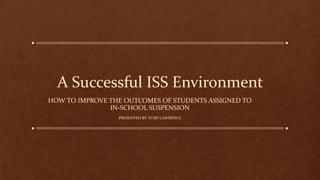
A successful iss environment
- 1. A Successful ISS Environment HOW TO IMPROVE THE OUTCOMES OF STUDENTS ASSIGNED TO IN-SCHOOL SUSPENSION PRESENTED BY: TORY LAWRENCE
- 2. A Successful ISS Environment Agenda • Purpose of ISS • Physical Environment • Teaching Replacement Behaviors • De-escalation Techniques
- 3. The Perception of In-school Suspension Common Incorrect Perceptions • ISS is a holding place for problem students • ISS is solely intended as a consequence • ISS in not a place where teaching occurs • ISS is used to keep out-of-school suspensions down What the Perception should be ISS is not just a consequence assigned for problem behavior but a method of teaching students replacement behavior so that the problem behavior is less likely to occur again
- 4. The Purpose of ISS • Allows schools to maintain safety and order in the school and intervene to address behavioral issues without excluding students from school • Students are not deprived of education. They can continue to receive academic support while they are excluded from class and school activities. • If there is no academic or prosocial component, ISS has little or no advantage over OSS. • Numerous studies have shown that, in order for a school to decrease its number of in-school suspensions, the ISS experience needs to be more constructive than punitive. (Child’s Defense Fund, 2014; Hrabak & Settles, n. d.; Morris & Howard,2003 )
- 5. The Purpose of ISS Ineffective ISS Characteristics • Assignments don’t accompany students • Little or no time is spent on correcting the behavior that got the student assigned to ISS • Lack of follow-up tends to allow a student to fall back into old patterns of behavior Effective ISS Characteristics • Holds students accountable for class assignments • Involves some aspect of rehabilitation or functional behavior assessment/replacement • Tracks the progress of students Hrabak & Settles (n. d.)
- 6. The Environment of ISS • Adequate physical space • Adequate amount of materials required for learning • Highly structured with routines & expectations clearly posted • Limited number of students assigned each day (15: 1 ratio recommended) • Current assignments present for each student (Child’s Defense Fund, 2014; Hrabak & Settles, n. d.)
- 7. Teaching Replacement Behavior ISS programs should include some way to address the problem behavior that resulted in the assignment If students do not learn a replacement for problem behaviors, infractions are likely to continue
- 8. Teaching Replacement Behavior • Addresses the skill deficit resulting in the problem behavior • Decreases the likelihood of the problem behavior reoccurring • Replacement behavior and social skills lessons can be taught in 10- 15 min lessons • Curriculums are readily available
- 9. How to Teach Replacement Behavior Teach the needed skill/desired behavior Model and Practice Assess Student demonstrates skill What if there is another behavior error? RETEACH
- 10. Resources for Teaching Replacement Behavior • Alternative Behavior Educator (ABE) • Social Skills and Character Education Curriculums • Online Resources
- 11. De-escalation Techniques 1. Be empathic and nonjudgmental When someone says or does something you perceive as irrational, try not to judge or discount their feelings. Whether or not you think those feelings are justified, they’re real to the other person. Pay attention to them. 2. Respect personal space. If possible, stand 1.5 to three feet away from a person who’s escalating. Allowing personal space tends to decrease a person’s anxiety and can help you prevent acting-out behavior. 3. Use nonthreatening nonverbal expression The more a person loses control, the less they hear your words—and the more they react to your nonverbal communication. Be mindful of your gestures, facial expressions, movements, and tone of voice. 4. Avoid overreacting. Remain calm, rational, and professional. While you can’t control the person’s behavior, how you respond to their behavior will have a direct effect on whether the situation escalates or defuses. 5. Focus on feelings. Facts are important, but how a person feels is the heart of the matter. Yet some people have trouble identifying how they feel about what’s happening to them. Watch and listen carefully CPI’s Top 10 De-Escalation Tips
- 12. De-escalation Techniques 6. Ignore challenging questions. Answering challenging questions often results in a power struggle. When a person challenges your authority, redirect their attention to the issue at hand. 7. Set Limits. If a person’s behavior is belligerent, defensive, or disruptive, give them clear, simple, and enforceable limits. Offer concise and respectful choices and consequences. 8. Choose wisely what you insist upon. It’s important to be thoughtful in deciding which rules are negotiable and which are not. For example, if a person doesn’t want to shower in the morning, can you allow them to choose the time of day that feels best for them? 9. Allow silence for reflection. We’ve all experienced awkward silences. While it may seem counterintuitive to let moments of silence occur, sometimes it’s the best choice. It can give a person a chance to reflect on what’s happening, and how he or she needs to proceed. 10. Allow time for decisions. When a person is upset, they may not be able to think clearly. Give them a few moments to think through what you’ve said. CPI’s Top 10 De-Escalation Tips
- 13. Interventions for Reoccurring ISS Assignments • Keep files for each student, tracking the behavior modification progress • Follow up with teachers to ensure that behavior is improving • First step – reteach problem behavior • Implement behavior contracts • Involve others - teachers, counselors, parents
- 14. References Children’s Defense Fund. (2014). Best practices: In-school suspension. Retrieved from http://www.childrensdefense.org/library/data/best-practices-in-school.pdf Hrabak, M. & Settles, D. (n. d.) Effective In-School Suspension Programs. Retrieved from https://www.kycss.org/pdfs-docs/clearpdf/issuesbriefs/iss.pdf Morris, R.C., & Howard, A.C. (2003). Designing an effective in-school suspension program, The Clearing House, 76, 156-159. CPI’s Top 10 De-Escalation Tips. (n. d.). Retrieved from http://www.crisisprevention.com/